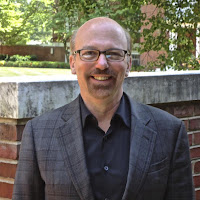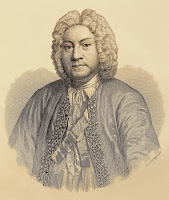Vocal Music
- Like as the Hart – Herbert Howells (1892-1983)
Instrumental Music
- Choral Dorien – Jehan Alain (1911-1940)
- Intermezzo in A Major – Johannes Brahms (1833-1897)
- Erhalt Un, Herr – Paul Manz (1919-2009)
Congregational Music (all hymns from The Hymnal 1982 with the exception of those marked “R” which are from Renew.)
- Hymn 522 - Glorious things of thee are spoken (AUSTRIA)
- Hymn 686 - Come, thou fount of every blessing (NETTLETON)
- Hymn 143- The glory of these forty days (ERHALT UNS, HERR)
- Hymn 679 - Surely it is God who saves me (THOMAS MERTON)
- Hymn R9 - As the Deer pants for the water (Martin Nystrom)
- Hymn 690 - Guide me, O thou great Jehovah (CWM RHONDDA)
- Psalm 95 - Tone IIa
Like as a Hart
Today's anthem is based on Psalm 42, where the Psalmist asks God why his heart is so sad and why he feels so far from God. It is by Herbert Howells, an British composer who was one of a long line of 19th and 20th century English composers who wrote anthems and service music for the Church of England.
 |
| Herbert Howells |
In the opinion of many musicians today, Howells rises to the top of the whole list. His compositions have the impeccable craft of a master composer and, above all, an exceptional poetic beauty. For example, in today's anthem Howells sets the phrase “so longeth my soul after thee, O God” to a long, sustained melody that perfectly evokes an inner soul’s intense hunger and longing to reside in the beautiful presence of a loving God. Likewise, when the sopranos first sing “My tears have been my meat day and night,” we feel their sadness which obviously has been going on for quite some time. Even the simple, final three chords on the organ can conjure up a whole series of emotions to different listeners.
Herbert Howells was born in Lydney, Gloucester and showed a keen interest in composition early in his life. At the age of eighteen, became a pupil of Herbert Brewer, Organist of Gloucester Cathedral. In 1912 he was awarded a scholarship to the Royal College of Music and studied under Charles Villiers Stanford, Walter Parratt, Charles Wood and Hubert Parry.
 |
| Jehan Alain |
The opening voluntary is a quiet piece written by the French organist Jehan Alain. Alain was the son of Albert Alain, one of the most influential organ builders and designers between the two world wars, wars, as well as a composer and organist himself. He was also the brother of organist Marie-Claire Alain, and she has spoken of how he influenced her own playing. In the Twenties and Thirties he attended the Paris Conservatoire, studying composition with Paul Dukas and Jean Roger-Ducasse and organ with Marcel Dupré. He won premiers prix in harmony, fugue, and organ. His marriage in 1935, birth of his children, and military service interrupted his studies, and he quickly began to earn a living as an organist, including a stint as an organist in a synagogue. Then World War II broke out, and he join the French Army, becoming a dispatch rider in the Eighth Motorized Armor Division. On 20 June 1940, he was assigned to reconnoiter the German advance on the eastern side of Saumur, and encountered a group of German soldiers at Le Petit-Puy. Coming around a curve, and hearing the approaching tread of the Germans, he abandoned his motorcycle and engaged the enemy. After using his machine gun to shoot several infantry soldiers who had ordered him to surrender, he fell mortally wounded. He was posthumously awarded the Croix de Guerre for his bravery, and was provisionally buried at the place where he had died.
He left behind his wife, Madeleine Payan, his three children, and a body of compositions viewed by many to have been amongst the most original of the 20th century. His early compositions are mainly songs and piano works. One also finds a few chamber pieces and one orchestral scores (an orchestration of an organ work), but most writers agree that his great achievement resides in his organ music which includes such classics as his three chorales (Choral Dorien, Choral Cistercien, Choral Phrygian), Variations sur un thème de Clément Jannequin, Litanies, Monodie, and Trois danses .
The Choral Dorien is one of Alain’s first published works, published when he was 24. It was not written in a major or minor key, but in one of the other harmonic modes used in the chants of the church. The word "choral" is the term used in French to mean " plain chant," so any French organist, accustomed as Alain was to the music of the Roman church, would understand thoroughly the "church modes."
 It is the perfect hymn to sing during the Lenten season. (The congregation gets a chance to sing it on Maundy Thursday.) "What Wondrous Love Is This" captures our attention right from the beginning with its simplicity and persistence – "What wondrous love is this" sung three times. This repetition is not the sign of a weak poet who has a narrow range of expression, but a fellow traveler who has experienced profoundly the sacrificial love of Christ and can only express again and again – "What wondrous love is this."
It is the perfect hymn to sing during the Lenten season. (The congregation gets a chance to sing it on Maundy Thursday.) "What Wondrous Love Is This" captures our attention right from the beginning with its simplicity and persistence – "What wondrous love is this" sung three times. This repetition is not the sign of a weak poet who has a narrow range of expression, but a fellow traveler who has experienced profoundly the sacrificial love of Christ and can only express again and again – "What wondrous love is this." 



